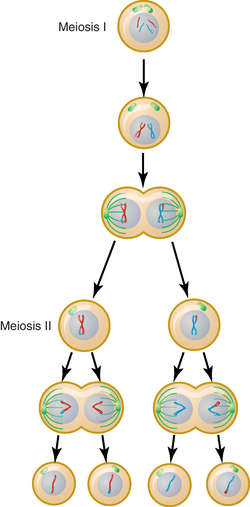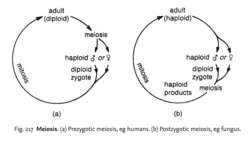meiosis
Also found in: Dictionary, Thesaurus, Encyclopedia, Wikipedia.
meiosis
[mi-o´sis]The first meiotic prophase is a complex process separated into five stages. During leptotene the chromosomes coil and contract; each consists of two chromatids joined along their length. During zygotene pairs of homologous chromosomes come into point-to-point contact along their length. This process is called synapsis and the structure formed is called a bivalent. The X and Y chromosomes synapse only at the ends of the short arms. During pachytene the chromosomes thicken, and the chromatids of each chromosome separate except at the centromeres. The bivalent is now a tetrad of four chromatids. During this stage crossing over occurs, in which the chromatids of homologous chromosomes break and rejoin, resulting in chromatids that contain sections derived from both the mother and the father. During diplotene the two chromosomes of each bivalent separate except for X-shaped chiasmata where crossover has occurred. In the female, this stage (called dictyotene) is prolonged; the oocyte remains in this stage from late fetal life until the time of ovulation. In the last stage, diakinesis, the chiasmata move to the ends of the chromosomes.
The other phases of meiosis I and II resemble those of mitosis, except that in meiosis I the two chromosomes of each bivalent separate and move to opposite poles. Thus, each daughter cell receives the haploid number of chromosomes, each with two chromatids. The assortment is random; either the maternal or the paternal chromosome can go to a daughter cell. Meiosis II then follows immediately without DNA replication. Both daughter cells formed by meiosis I divide again and the two chromatids of each chromosome separate and go to separate daughter cells. This produces four haploid daughter cells with chromosomes composed of single chromatids.

mei·o·sis
(mī-ō'sis), Do not confuse this word with miosis.meiosis
(mī-ō′sĭs)meiosis
The process of nuclear division whereby cells divide without replicating chromosomes, producing mature eggs and sperm with a haploid number of chromosomes. Meisosis is a type of cell division required for sexual reproduction, which consists of two nuclear divisions:(1) In the first division, the chromosomes undergo recombination, forming different genetics in each daughter gamete—each of which has a full (diploid) complement of chromosomes—which is essentially what occurs in mitosis;
(2) In the second division, the diploid complement is reduced to a haploid number.
The resulting cells contain one part of each pair of homologous chromosomes, which allows the haploid daughter cell from the mother (ovum) to combine with a haploid daughter cell from the father (sperm).
mei·o·sis
(mī-ō'sis)meiosis
(mi-o'sis) [Gr. diminution]meiosis
The process in the formation of the sperms (spermatozoa) and eggs (ova) in which chromosomal material undergoes recombination (meiosis I) and the chromosomes are reduced to a single set of 23 (haploid number) instead of the normal 23 pairs (meiosis II). This allows the restoration of the normal number when the spermatozoon fuses with the ovum. See also MITOSIS.meiosis
a type of nuclear division associated with sexual reproduction, producing four HAPLOID (1) cells from a single DIPLOID (1) cell, the process involving two cycles of division. Although meiosis is a continuous process it has been divided into numerous stages, given below. Further details of each stage can be obtained by referring to individual entries.PROPHASE I: homologous chromosomes pair, split into CHROMATIDS, and carry out CROSSING OVER. The nuclear membrane disintegrates.
METAPHASE I: chromosomes migrate to the spindle equator to which they become attached by their CENTROMERES. ANAPHASE I: HOMOLOGOUS CHROMOSOMES separate to opposite poles. TELOPHASE I: new nuclei form, in which there is only one type of each chromosome, although each is divided into two chromatids. PHOPHASE II: nuclear membrane goes. METAPHASE II: chromosomes attach to spindle. ANAPHASE II: chromatids separate to poles. TELOPHASE II: a total of four haploid nuclei is produced, each with one of each type of chromosome.
Meiosis has two major functions:
- it halves the number of chromosomes to prevent a doubling in each generation,
- it produces a mixing of genetic material in the daughter cells by the process of INDEPENDENT ASSORTMENT and RECOMBINATION. Note that the second point is only true if variability already is present in the parent cell.
Meiosis occurs at different stages of the life cycle in haploid and diploid organisms. See Fig. 217 . See also MITOSIS, GAMETOGENESIS and Figs. 167 and 168 .

